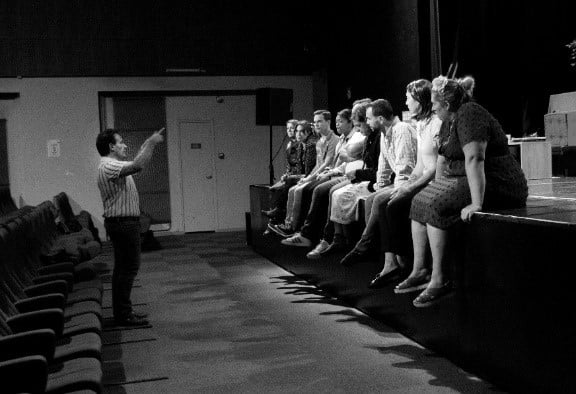Successful public speaking is a prerequisite for leadership. The company is a microcosm made up of postures and communication, with demanding interpersonal skills. Managers need to master the art of speaking in order to establish their legitimacy and win the trust and support of their staff. Fortunately, knowing how to speak is not something you're born with, it's something you learn and work on! Between naturalness, strategy and improvisation, it's a question of acquiring know-how as well as interpersonal skills. So what are the best techniques for successful speaking? Nicolas Bret-Morel, actor, director and trainer specialising in public speaking, explains.

Leadership: elements of definition
Everyone has their own idea of leadership! For some, it's the art of motivating. For others, leadership means results. Still others need to feel inspired by a leader. In any case, the notion of leadership is not new. And neither is its link with communication - by extension, speaking out!
[Fun fact]
The first traces of the notion of leadership can be found in Egyptian hieroglyphics: the leader (seshemet) and his followers (shemsu).
What are the qualities of good leadership?

Nicolas Bret-Morel
"I manage trainees as well as 11 actors each year in my troupe Les pendrillons rouges.
Successful speaking requires leadership and vice versa. It is therefore essential to identify the key elements of leadership if you are to make an impact when you speak.
Key words in leadership
| VISIONARY | Vision and sharing | Being a leader means having vision and some share with others. |
| MOTIVATE | Encourage | One of the main functions of a leader is to motivate. |
| EMPATHY | Emotional intelligence | We also talk aboutemotional intelligenceThe ability of leaders to put themselves in other people's shoes and understand their concerns. |
| CREATIVE | Imagination | Leaders are able to create an environment that encourages all members of their team to develop their skills and potential. imaginationto contribute to the joint project. |
| REQUIREMENT | Setting an example | A good leader sets the bar high for his people because he wants to achieve his objectives and get the best out of his team. They must also be exemplary and demanding of themselves. |
| LEAD | Visit | The leader must be in the lead to lead and guide to his team. |
| CREATING A TEAM | Collaborate | The leader seeks to work as part of a team to achieve a common goal. |
| IMPROVE | Questioning | The leader seeks continuous improvement at all times. |
To sum up, leadership has nothing to do with hierarchy or with imposing. Rather, it is an attitude adopted by people who want to something different. They pass on their convictions to others through optimism to achieve a common goal.
[Training]
Developing oral presence and leadership skills
A training programme punctuated by numerous practical exercises Postural, vocal and behavioural training, miming a text, creating a character, acting out a scene... 2 days to experiment, work on your posture and become more convincing.
[Feedback from participants]
"It was rich and interactive. I feel I have the tools to improve my posture.
"A lot of practice, very concrete. You can see straight away how to apply what you've learned. "Just incredible! Great presentation, great participation, practical exercises, nothing to complain about.
Identifying and overcoming your own fears: a prerequisite for leadership
A limiting belief is a a body of knowledge, thought or way of life inculcated from childhood. In other words, a package passed on to children by parents, teachers... and by everyone around them. Added to this are the beliefs acquired in adulthood, as a result of life experiences.
The result? A belief system that determines the direction and quality of everyone's life. In both the personal and professional spheres.
The remedy? Replace limiting beliefs with energising beliefs.
[Good practice]
3 keys to transforming your limiting beliefs :
- Building your self-confidence
- Free yourself from the gaze of others
- Don't be afraid of your mistakes
To fail is to have the opportunity to start again in a more intelligent way.
Henri Ford
Exercise: write down the blocking belief, then make 3 columns
- How has this belief ever held me back before?
- What else is it going to cost me if I continue to maintain it?
- If I can get rid of it, what positive changes will my life bring?
Leadership: develop your strengths for successful speeches
The actor's trick? A state of mind! So, like him, say to yourself: "Nothing is possible without me!
After all, everything starts from what you project onto the other person. To create the conditions for a real encounter, you need to take into account your own state of mind and combine it with the assets that will help you develop your relationship.
4 major assets for your leadership
1/ The look
Firstly, it's only your intention that changes it. In other words, if you think or verbalise your intention, your gaze will translate it in your own way.
Example: "I want to be welcoming and caring".
Secondly, the proximity of your gaze affects its power. So make sure you keep the right distance for the situation.
2/ The voice
90 % of people don't like their voice when they hear it! Why is that?
The main reason is that they don't recognise it. It's a question of resonators and vibrations (larynx, labial, nasal, etc.) perceived by the inner ear.
The other reason: the voice can betray emotions, state of mind and personal history. For example, a low, self-effacing voice is often the sign of a lack of self-confidence.
The voice, through the intonation, volume and rhythm of the sentences, nurtures and animates the conversation and the relationship.
Tips for working on your voice
1/ Reading aloud
In the theatre, this is called projected voice.
Practise a sentence with a fast flow and then a slower flow. Modulation adds rhythm to the speech.
2/ Working on your elocution and vocal clarity using tongue twisters
Example: The Archduchess's socks...
3/ Recording, listening and correcting yourself
[ Training ]
Developing your voice for greater impact when speaking
The voice is a powerful communication tool.
Learn how to work on your voice to become more convincing, more authentic and more impactful.
3/ The smile
The smile is universal, regardless of age or culture. Spontaneous, it expresses empathy and benevolence. It makes it easier to "meet" people. Conversely, a "forced" smile is noticeable and conveys a feeling of unease.
4/ Body language
According to a study by Dr Albert Mehrabian, a psychologist at the University of California, the majority of the message retained by those who have listened to it does not concern the words spoken but rather the way in which they were said, expressed and shown. This non-verbal communication is based on body language as a whole: gestures, postures, body and facial expressions.
Tips for working on your body language
1/ It's essential that everything is aligned: in other words, congruent.
Be "in tune" with what you think, say and show.
2/ Avoid closing gestures
- Stiff body and tense muscles
- Standing with dancing body or crossed legs
- Sitting with floating feet or slumped body
- Arms crossed, shoulders locked, face closed and eyes averted
3/ On the contrary, opt for gestures of openness
- Relaxed, toned body
- Standing and anchored to the ground
- Sitting with feet flat and back straight
- Free arms and supple shoulders
- Smiling face and straight eyes
Improvisation for leadership and public speaking
This is not the role of a leader than to improvise, but it's a real quality to know how to improvise.
Improvisation makes a lot of things possible:
- letting go and welcoming the unexpected
- to have the right to be someone else
- play down failure
- learning to listen and accept what the other person says
- getting used to getting out of any situation
- gain confidence in yourself and your ideas
- train to DARE
[Training]
Knowing how to improvise to react and control your communication
How can you be at ease and react effectively in any communication situation?
4 objectives:
- Developing your self-confidence and charisma
- Adapting to group reactions
- Moving away from justification and towards explanation
- Respond to objections methodically
Work on your eloquence!
Eloquence is "the art of speaking well". It means pleasing, moving and convincing through the power of the spoken word. The power of the spoken word is the power to sell and to sell yourself. Eloquence is what gets you out of any situation. It's what enables you to be right even when you're wrong!
A few keys to successful speaking:
| Pleasing | Use a gentle, comforting tone. |
| Being moving | Let yourself be natural and let your emotions flow. |
| Resting and warming up | Your body and voice need to be rested, then warmed up with exercises to loosen up the muscles and warm up the resonators. For example: massage your mouth, lips, cheeks and neck. On a deep breath, recite the vowels continuously to calmly warm up your vocal cords. |
| Insurance | Show that you're sure of what you're saying, with a steady gaze that doesn't waver. A steady voice too. In theatre, you can use a voice called "from below" (i.e. speaking in a low voice). |
| Speech | It should be regular, neither too slow nor too fast. It helps with comprehension. |
| Being convincing | You need to know your subject. Don't be hesitant, don't seem to be searching for your ideas. |
Ultimately, everyone can develop their leadership skills and improve their public speaking. This can be done through training. But there is also a particularly beneficial activity for working on your strengths: theatre. Because theatre is all about watching and listening. Looking where you're going, looking at others and listening to them. It's also about being able to catch people's eyes and to move around a space with your gaze. Finally, it's about being able to communicate with an audience through the emotion conveyed by those eyes.





